英语经典错题演示教学
八年级英语上册典型错题及解析
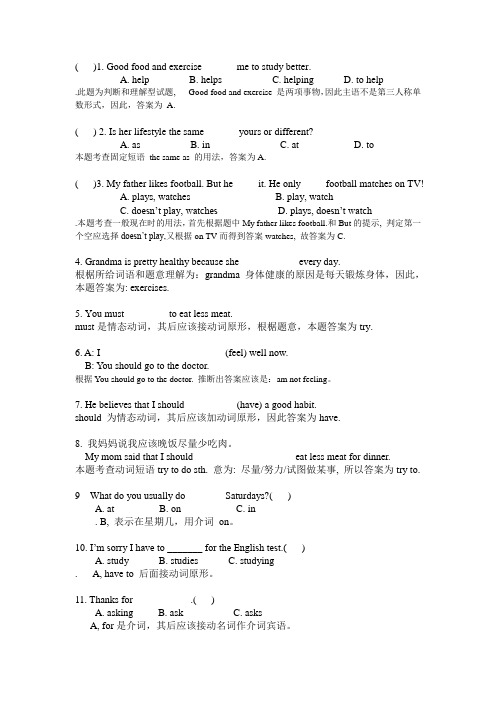
()1. Good food and exercise ______ me to study better.A. helpB. helpsC. helpingD. to help.此题为判断和理解型试题,Good food and exercise 是两项事物,因此主语不是第三人称单数形式,因此,答案为A.() 2. Is her lifestyle the same ______ yours or different?A. asB. inC. atD. to本题考查固定短语the same as 的用法,答案为A.()3. My father likes football. But he ____ it. He only ____ football matches on TV!A. plays, watchesB. play, watchC. doesn’t play, watchesD. plays, doesn’t watch.本题考查一般现在时的用法,首先根据题中My father likes football.和But的提示, 判定第一个空应选择doesn’t play,又根据on TV而得到答案watches, 故答案为C.4. Grandma is pretty healthy because she ___________ every day.根椐所给词语和题意理解为:grandma 身体健康的原因是每天锻炼身体,因此,本题答案为: exercises.5. You must ________ to eat less meat.must是情态动词,其后应该接动词原形,根椐题意,本题答案为try.6. A: I ______ _________ ________ (feel) well now.B: You should go to the doctor.根据You should go to the doctor. 推断出答案应该是:am not feeling。
英语常见错题解析
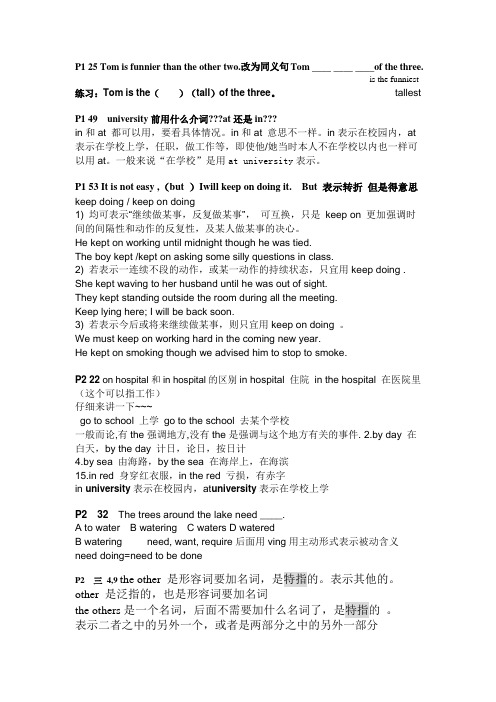
P1 25 Tom is funnier than the other two.改为同义句Tom ____ ____ ____of the three.is the funniest 练习:Tom is the()(tall)of the three。
tallestP1 49 university前用什么介词???at还是in???in和at 都可以用,要看具体情况。
in和at 意思不一样。
in表示在校园内,at 表示在学校上学,任职,做工作等,即使他/她当时本人不在学校以内也一样可以用at。
一般来说“在学校”是用at university表示。
P1 53 It is not easy ,(but )Iwill keep on doing it. But 表示转折但是得意思keep doing / keep on doing1) 均可表示“继续做某事,反复做某事”,可互换,只是keep on 更加强调时间的间隔性和动作的反复性,及某人做某事的决心。
He kept on working until midnight though he was tied.The boy kept /kept on asking some silly questions in class.2) 若表示一连续不段的动作,或某一动作的持续状态,只宜用keep doing . She kept waving to her husband until he was out of sight.They kept standing outside the room during all the meeting.Keep lying here; I will be back soon.3) 若表示今后或将来继续做某事,则只宜用keep on doing 。
We must keep on working hard in the coming new year.He kept on smoking though we advised him to stop to smoke.P2 22 on hospital和in hospital的区别in hospital 住院in the hospital 在医院里(这个可以指工作)仔细来讲一下~~~go to school 上学go to the school 去某个学校一般而论,有the强调地方,没有the是强调与这个地方有关的事件. 2.by day 在白天,by the day 计日,论日,按日计4.by sea 由海路,by the sea 在海岸上,在海滨15.in red 身穿红衣服,in the red 亏损,有赤字in university表示在校园内,at university表示在学校上学P2 32 The trees around the lake need ____.A to waterB wateringC watersD wateredB watering need, want, require后面用ving用主动形式表示被动含义need doing=need to be doneP2 三4,9 the other 是形容词要加名词,是特指的。
英语试卷讲评课教案 (2)
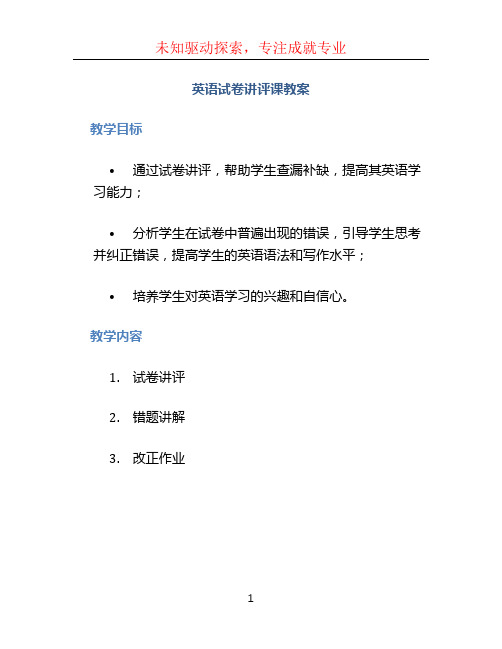
英语试卷讲评课教案教学目标•通过试卷讲评,帮助学生查漏补缺,提高其英语学习能力;•分析学生在试卷中普遍出现的错误,引导学生思考并纠正错误,提高学生的英语语法和写作水平;•培养学生对英语学习的兴趣和自信心。
教学内容1.试卷讲评2.错题讲解3.改正作业教学步骤第一步:试卷讲评(10分钟)1.学生交出试卷;2.教师快速浏览试卷,做一些整体评价;3.教师列举一些学生普遍出现的错误,如:动词时态的误用、名词单复数的错误、冠词的使用等;4.引导学生思考和解答,纠正错误。
第二步:错题讲解(30分钟)1.教师根据试卷,选择一些学生普遍错的题目进行讲解;2.教师解答学生提出的问题,并给出相应的解析;3.学生记录讲解的重点内容。
第三步:改正作业(20分钟)1.学生拿出最近一次作业;2.教师逐一让学生上台将自己的错题进行讲解;3.教师和其他学生进行点评,并给出修改建议。
第四步:总结反思(10分钟)1.教师和学生一起总结学习内容,复习重点知识;2.学生发表个人感受,教师给予鼓励和肯定;3.教师布置下一次作业。
教学资源•学生试卷•错题解析材料•黑板/白板•讲义•笔记本电脑或投影仪(可选)教学评估•学生在课堂上能积极参与讨论,提出问题并解答问题;•学生对错题和讲解内容进行了记录和总结;•学生在下一次作业中能够纠正之前犯过的错误。
参考资料•《英语学习指导手册》•《英语语法详解》•《英语写作范文集》这个教案是一堂关于英语试卷讲评的课程计划。
通过分析学生在试卷中的错误,并进行针对性讲解和纠正,旨在帮助学生提高他们的英语学习能力和英语应试技巧。
同时,通过这个课程,培养学生对英语学习的兴趣和自信心。
通过试卷讲评,学生能够了解自己在哪些方面存在问题。
教师可以列举一些学生普遍出现的错误,然后引导学生思考和解答,从而帮助他们纠正错误。
同时,教师可以选择一些学生普遍错的题目进行讲解,解答学生提出的问题,并给出相应的解析,帮助学生更好地理解和掌握知识点。
小学英语《四年级英语下册第一次月考试卷讲评》优质课教学设计、教案
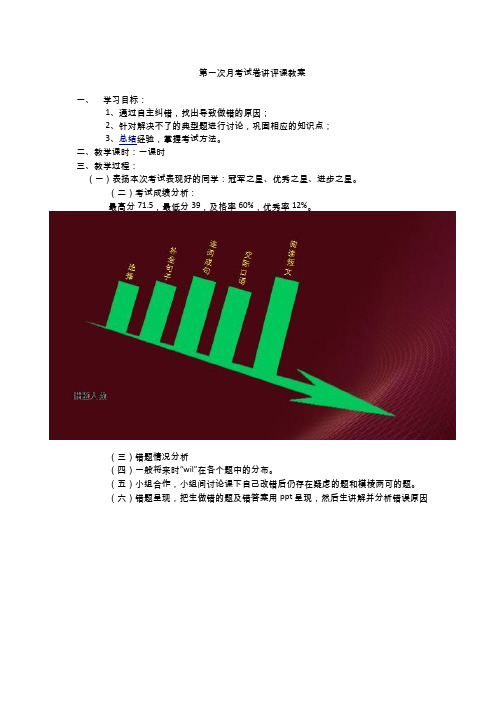
第一次月考试卷讲评课教案一、学习目标:1、通过自主纠错,找出导致做错的原因;2、针对解决不了的典型题进行讨论,巩固相应的知识点;3、总结经验,掌握考试方法。
二、教学课时:一课时三、教学过程:(—)表扬本次考试表现好的同学:冠军之星、优秀之星、进步之星。
(二)考试成绩分析:最高分71.5,最低分39,及格率60%,优秀率12%。
(三)错题情况分析(四)一般将来时“wil”在各个题中的分布。
(五)小组合作,小组间讨论课下自己改错后仍存在疑虑的题和模棱两可的题。
(六)错题呈现,把生做错的题及错答案用ppt 呈现,然后生讲解并分析错误原因(七)(八)加强记忆。
呈现周一至星期天(Monday ............. Sunday)生以开火车形式识记。
(九)生以游戏方式检测复习天气的词语并归纳总结此类词的特点。
Today is Monday and tomorrow is Tuesday.Today is Tuesday and tomorrow is Wednesday.Today is Wednesday and …(十)试题反馈,针对以上错误率较高的题及重点知识考察的题进行同类型改编加以检测和巩固。
生在练习本做完并由生讲解。
1Will it (sunny\be sunny) next week?2It (will be\will) cold tomorrow.3 Will it (rain\windy) on Sunday?4 will , It , Friday, sunny, be, on. (连词成句)1.Today is Saturday and tomorrow is .A.MondayB.SundayC.Tuesday2.What will you do on Friday?I play football.A. willB. canC.am3.I will the on Sunday.(十一)阅读讲解(此篇阅读主要涉及前面错误率高的知识)( 1 )生在读文章并着重讲解其中两道错的多的题,T omorrow is Sunday.My father,mother and I are going to the park.My father will take his camera. He will take some photos for us. My mother will take some good thingsto eat.She will take a kite ,too. And she will fly it in the park.How happy we are!(2)师带领学生总结规律1 略读文章2.读题和选项3. 细读题目所在的句子4.做题5.检查(3)再次反馈此文章所涉及的其他三道题(生根据总结的阅读规律划出其他三道题在文章的句子)。
初三英语错题和解析100题
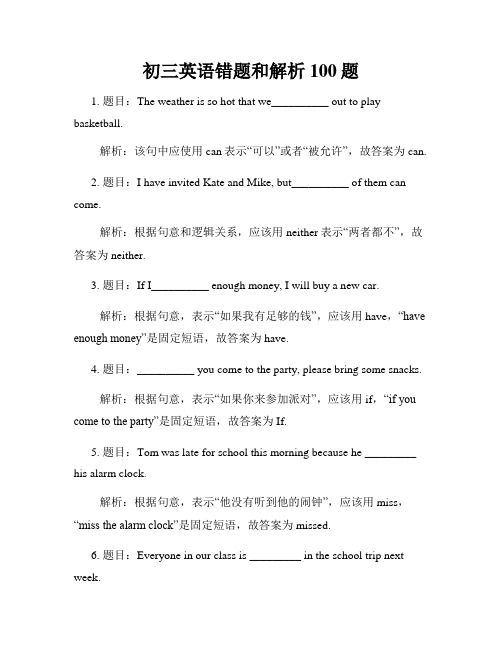
初三英语错题和解析100题1. 题目:The weather is so hot that we__________ out to play basketball.解析:该句中应使用can表示“可以”或者“被允许”,故答案为can.2. 题目:I have invited Kate and Mike, but__________ of them can come.解析:根据句意和逻辑关系,应该用neither表示“两者都不”,故答案为neither.3. 题目:If I__________ enough money, I will buy a new car.解析:根据句意,表示“如果我有足够的钱”,应该用have,“have enough money”是固定短语,故答案为have.4. 题目:__________ you come to the party, please bring some snacks.解析:根据句意,表示“如果你来参加派对”,应该用if,“if you come to the party”是固定短语,故答案为If.5. 题目:Tom was late for school this morning because he _________ his alarm clock.解析:根据句意,表示“他没有听到他的闹钟”,应该用miss,“miss the alarm clock”是固定短语,故答案为missed.6. 题目:Everyone in our class is _________ in the school trip next week.解析:根据句意,表示“对下周的学校旅行感到兴奋”,应该用excited,“excited about the school trip”是固定短语,故答案为excited.7. 题目:The film was _________ good that I watched it twice.解析:根据句意,表示“这部电影非常好”,应该用so,“so good”是固定短语,故答案为so.8. 题目:Jennifer has been _________ for ten years. She knows a lot about fashion.解析:根据句意,表示“Jennifer从事时尚工作已经十年了”,应该用in,“in fashion”是固定短语,故答案为in.9. 题目:I'm sorry I _________ my key at home. I can't get into the house.解析:根据句意,表示“我把我的钥匙忘在家里了”,应该用left,“left my key at home”是固定短语,故答案为left.10. 题目:The little girl _________ at the sight of the spider.解析:根据句意,表示“小女孩一看到蜘蛛就哭了”,应该用cried,“cried at the sight of the spider”是固定短语,故答案为cried.......(继续完成剩余的90道题目)通过以上100道题目的解析,我们可以学到很多英语知识和语法规则。
初中英语学习中如何进行有效的错题分析和总结?
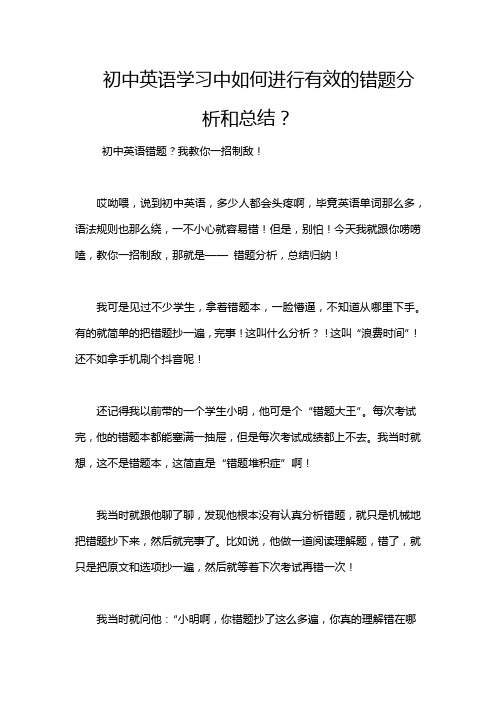
初中英语学习中如何进行有效的错题分析和总结?初中英语错题?我教你一招制敌!哎呦喂,说到初中英语,多少人都会头疼啊,毕竟英语单词那么多,语法规则也那么绕,一不小心就容易错!但是,别怕!今天我就跟你唠唠嗑,教你一招制敌,那就是——错题分析,总结归纳!我可是见过不少学生,拿着错题本,一脸懵逼,不知道从哪里下手。
有的就简单的把错题抄一遍,完事!这叫什么分析?!这叫“浪费时间”!还不如拿手机刷个抖音呢!还记得我以前带的一个学生小明,他可是个“错题大王”。
每次考试完,他的错题本都能塞满一抽屉,但是每次考试成绩都上不去。
我当时就想,这不是错题本,这简直是“错题堆积症”啊!我当时就跟他聊了聊,发现他根本没有认真分析错题,就只是机械地把错题抄下来,然后就完事了。
比如说,他做一道阅读理解题,错了,就只是把原文和选项抄一遍,然后就等着下次考试再错一次!我当时就问他:“小明啊,你错题抄了这么多遍,你真的理解错在哪里了吗?你是对哪个选项有疑问?你是哪个单词不认识?还是你根本理解不了文章的意思?”小明一脸茫然,说:“老师,我不太懂,我就感觉都挺像的,然后就选错了。
”哎呦,听完这话我真是醉了!这哪里是分析错题,分明是逃避学习啊!所以我当时就耐心地教他,应该怎么分析错题。
首先,要找到错误的根源。
是单词不会?语法不懂?还是理解能力不够?然后要针对不同的错误进行不同的分析。
比如,如果是单词问题,就要查词典,把单词的音标、词性、意思都记下来,并且要造句子练习,才能把单词真正记牢。
如果语法问题,就要看相应的语法规则,理解语法点,并且做一些针对性的练习题,才能真正掌握语法知识。
如果是理解能力问题,那就要多读多练,提高阅读理解能力。
我当时还教小明,把错题按照分类整理,比如单词错题、语法错题、阅读理解错题等等,方便以后复习。
小明听了我的建议,开始认真分析自己的错题,并且把错题整理成册。
经过一段时间的努力,他的英语成绩终于有了明显的提高。
所以,别再像小明一样,拿着错题本像个茫然的小白兔了!抓住错题的“七寸”,认真分析每一个错误,把错误变成宝贵的学习资源,你也会像小明一样,轻松掌握初中英语!记住!错题分析不是简单的抄抄写写,而是要带着问题,深入思考,查漏补缺,才能真正起到提高学习效率的作用!。
英语错题分析知识点总结

英语错题分析知识点总结IntroductionIn the process of learning English, students often encounter various types of mistakes in their exam papers or exercises. In order to improve their English level, it is necessary to analyze these errors and summarize the relevant knowledge points. In this paper, we will analyze and summarize some common English mistakes, and provide a comprehensive summary of the relevant knowledge points.Section 1: Incorrect Use of ArticlesError 1: "I want to become an engineer and help people."Explanation: The correct sentence should be "I want to become an engineer and help the people."Analysis: The error here lies in the incorrect use of the definite article "the." In English, when referring to a specific group of people, the definite article "the" should be used before the noun.Error 2: "She is excellent violinist."Explanation: The correct sentence should be "She is an excellent violinist."Analysis: The error here is the omission of the indefinite article "an" before the noun "violinist." In English, when referring to a singular countable noun, the indefinite article "a/an" should be used before the noun.Knowledge Points Summary:1. The definite article "the" is used to refer to specific nouns, while the indefinite articles "a/an" are used to refer to non-specific nouns.2. The use of articles is an important aspect of English grammar and it is essential to use them correctly in order to convey precise meaning.Section 2: Incorrect Use of Verb TensesError 1: "I see him yesterday."Explanation: The correct sentence should be "I saw him yesterday."Analysis: The error here lies in the incorrect use of the present tense verb "see" instead of the past tense verb "saw." In English, verb tenses should be used in accordance with the time frame of the action being described.Error 2: "She have lived in London for five years."Explanation: The correct sentence should be "She has lived in London for five years."Analysis: The error here is the incorrect use of the auxiliary verb "have" instead of "has." In English, when the subject is a singular third person (he/she/it), the present perfect tense requires the use of "has" as the auxiliary verb.Knowledge Points Summary:1. English verb tenses are used to indicate the time frame of an action or event, and it is important to use them correctly in order to convey accurate information.2. The correct use of auxiliary verbs and verb forms is crucial for proper grammar and sentence construction.Section 3: Incorrect Use of PrepositionsError 1: "I am interested on learning new languages."Explanation: The correct sentence should be "I am interested in learning new languages."Analysis: The error here is the incorrect use of the preposition "on" instead of "in." In English, the preposition "in" is used to indicate interest or involvement in a particular activity.Error 2: "He is good at to play the piano."Explanation: The correct sentence should be "He is good at playing the piano."Analysis: The error here is the unnecessary use of the infinitive "to" before the verb "play." In English, the preposition "at" is followed by the gerund form of the verb.Knowledge Points Summary:1. Prepositions are used to indicate the relationship between nouns, pronouns, and other words in a sentence, and it is important to use them correctly to convey precise meaning.2. The correct use of prepositions is essential for proper sentence structure and grammar. Section 4: Incorrect Subject-Verb AgreementError 1: "The team plays well together."Explanation: The correct sentence should be "The team play well together."Analysis: The error here is the incorrect agreement between the singular subject "team" and the plural verb "plays." In English, the verb should agree with the subject in terms of number.Error 2: "One of the students have already finished the exam."Explanation: The correct sentence should be "One of the students has already finished the exam."Analysis: The error here is the incorrect agreement between the singular subject "one" and the plural verb "have." In English, when the subject is "one of" followed by a plural noun, the verb should be singular.Knowledge Points Summary:1. Subject-verb agreement is a crucial aspect of English grammar, and it is important to use verbs that agree with their subjects in terms of number.2. The correct understanding and application of subject-verb agreement is essential for constructing grammatically accurate sentences.ConclusionIn this paper, we have analyzed and summarized some common English mistakes in the areas of articles, verb tenses, prepositions, and subject-verb agreement. By understanding these errors and the relevant knowledge points, students can improve their English language skills and effectively avoid making similar mistakes in the future. It is important to continuously review and practice these grammar rules in order to enhance English proficiency and achieve better academic performance.。
小学六年级英语上册错题解析(附例题及答案)

小学六年级英语上册错题解析(附例题及答案)错题解板1.W h e r e i s t h e p o s t o f f i c e?I t’s w e s t____t h e c i n e m a .A .i nB .o n C.o f这题主要考查介词的用法。
大多数学生选择了i n,要注意固定搭配的使用。
2.W h a t a r e y o u g o i n g t o d o t h i s a f t e r n o o n?A .I’m g o i n g t o b u y a b o o k .B .I’m g o i n g t o t h e b o o k s t o r e .C .I’m g o i n g t o a t3o’c l o c k..这题主要讲“干什么,做什么”选A比较好。
3.S a r a h,l e t’s_____t o t h e p a r k t h i s a f t e r n o o n..g o B.g o i n g C .w e n t应该填g o,这里用l e t s b.d o s t h.的用法。
因此,选A.4.N o w l e t____t e l l y o u h o w t o c o m e .m y B.h i s C.m e这题还是用上题这个词组,这里考查动宾结构,故选择C。
5.G o s t r a i g h t_____-f i v e m i n u t e s.A.o nB.f o rC.i n这题考查介词的用法,五分钟表示一段时间,故要用介词f o r .6.T h e h o s p i t a l i s f a r___o u r s c h o o l .A .t oB .f r o m C.f o r动词短语f a r f r o m是固定搭配,因此要选B.“离······远”。
英语错题本范本教学文稿

英语错题本范本For personal use only in study and research; not for commercial use初中生应该如何正确地做英语错题本(2012-11-08 15:13:29)转载▼标签:乐加乐学而思英语初中教育2011年4月,我带的第一届学生正在为2个月后的中考做最后的冲刺。
那时候的孩子们,实在是让人不忍苛责。
他们成绩有高有低,但大都非常焦虑。
初中英语那点知识早就已经学完了,连复习都已经进入到第三遍,正可谓“翻开书一目了然,合上书一片茫然”。
他们每天都要做很多题,因为他们除了做题没什么别的可以做。
每天一套模拟题,分数高一点,就非常开心,仿佛这预示着自己中考的分数也会高一点;分数低一点,那么,是时候再来一套了!我将这种状态称为“模拟题狂热症”,这是在考前冲刺的最后阶段极容易陷入的一个状态。
但是,也有少数孩子非常“淡定”,每天忙而不乱,有条不紊地进行着知识的整理和总结,最后取得了很好的效果。
为什么他们这么淡定?就是因为他们做了错题本。
一个小小的本子能有这么大的作用吗?是的。
在冲刺阶段,大家的知识水平都已经差不多,就看谁有方向,谁更淡定,谁能够脚踏实地地学习。
而错题本能清楚地展示出孩子的知识漏洞所在,帮助孩子明确最后阶段的复习方向。
错题本这件事,早做比晚做强,晚做也比不做强。
即便到考前最后10天,踏踏实实地整理一下错题,也比盲目地东看一眼、西碰一下有效得多。
而从学习的开始阶段就养成做错题本的习惯,对孩子的发展更是大有裨益。
这次我们给孩子们设计这个英语笔记本+错题本(前面一半是笔记本,后面一半是错题本),就是希望帮助孩子们养成这个习惯。
那么,错题本应该怎么做呢?不同类型的题目应该怎么处理?在这里,我把英语题目分两个类型来说明。
1.语法题(包括单项选择、句型转换等题型)这类题目往往较短,整理起来较为轻松。
比较好的做法是,在一页纸的左侧记录题目(黑笔),右侧记录错误答案和正确答案(红笔)。
七年级英语上册典型错题及解析

1. ____ pen is red.A. ItB. AC. TheD. It 's正解:C学生会误选B,不清楚定冠词与不定冠词之间的区别。
2. ________________ --What 'shis name ?--His name is .A. Zhu GeliangB. Zhuge LiangC. Zhu GeLiangD. Zhu Ge Liang 正解:B很多学生都选了A,作为常识,不知道诸葛是复姓,不清楚英语中名和姓的首字母才大写。
3.I'm Jim Brown and my f _____ name is Brown.正解:family不少学生写成了first name ,对名和姓的区分是一个易混淆的难点。
4. I ____ a student.A. isB. amC. are正解:B错选A,对be动词的掌握不扎实,I am, you are,单数is复数are5. --What 'sthis?-- ________ is a pencil sharpener.A. ThisB. ThatC. HeD. It 正解:D错选A,不会用代词it,而根据中文习惯去组织英文。
6. --What 'sthis? -- ________ .A. A watchB. It'swatchC. It'sa watchD. A and C正解:D没有考虑全面而选C7. Jim is my friend. ______ an English boy. ( He 's, His )正解:He's不少学生用his,只因出现次数多,没有理解两者区别。
8. 连词成句nice; is; quilt; this (.)Is; backpack; his; red (?)正解:This quilt is nice. Is his backpack red? 许多学生写成:This is nice quilt. 及Is his red backpack?9. --- ____ ( Is; Are ) your name Jack?--- No, I am John.正解:Is选Are 的学生主要是you, your 不分,这并不是个别现象。
小学英语错题案例范文

小学英语错题案例范文Title: Case Study of Common Mistakes in Primary School EnglishIn the realm of primary school education, English learning often presents unique challenges for young students. These challenges often manifest in the form of common mistakes that students repeatedly make, reflecting their developing understanding of the language and its nuances. This case study aims to explore and analyze a few such mistakes, providing insights into their root causes and offering strategies for improvement.Case 1: Confusion with HomophonesOne common mistake observed in primary school English is the confusion between homophones - words that sound alike but have different meanings and spellings. For instance, students often mix up "their" and "there," or "its" and "it's." This confusion often arises due to the students' limited vocabulary and their reliance on sound rather than meaning to remember words.To address this issue, teachers can encourage students to practice using these words in context, emphasizing the difference in meaning. Visual aids, such as charts or posters, can also be used to illustrate the distinction between homophones. Additionally, regular quizzes and games that focus on homophones can help students solidify their understanding.Case 2: Inconsistent Use of Verb TensesAnother common mistake in primary school English is the inconsistent use of verb tenses. Students often fail to distinguish between present, past, and future tenses, leading to errors in sentence construction. For example, they might use the present tense to describe a past event or vice versa.To correct this mistake, teachers can provide explicit instruction on the use of different verb tenses, including examples and practice exercises. They can also encourage students to read and write regularly, as this helps them develop a sense of when each tense is appropriate. Additionally, teachers can create fun activities, such asrole-playing or storytelling, that require students to use verbs correctly in different contexts.Case 3: Difficulty with Article UsageThe correct use of articles ("a," "an," and "the") is another area where primary school students often struggle. They may omit articles altogether or use them incorrectly, such as using "a" instead of "the" when referring to a specific noun.To improve article usage, teachers can provide clear explanations of the rules governing article usage, emphasizing the difference between countable and uncountable nouns. Regular practice exercises, includingfill-in-the-blank sentences or correction activities, can also be beneficial. Additionally, teachers can encourage students to pay attention to article usage in their reading materials, pointing out examples as they encounter them.ConclusionIn conclusion, common mistakes in primary school English reflect the students' developing language skills and understanding. By addressing these mistakes throughexplicit instruction, regular practice, and engaging activities, teachers can help students overcome these challenges and enhance their English proficiency. It is essential to remember that patience and encouragement are key in this process, as students need time to internalize new language rules and apply them accurately.While this case study has focused on a few specific examples, it is important to note that each student's learning journey is unique. Therefore, teachers should adapt their teaching strategies to meet the individual needs of their students, providing targeted support and feedback as necessary. By doing so, they can help students build a solid foundation in English that will serve them well throughout their academic and personal lives.。
六年级英语质量监测试卷讲评课教案
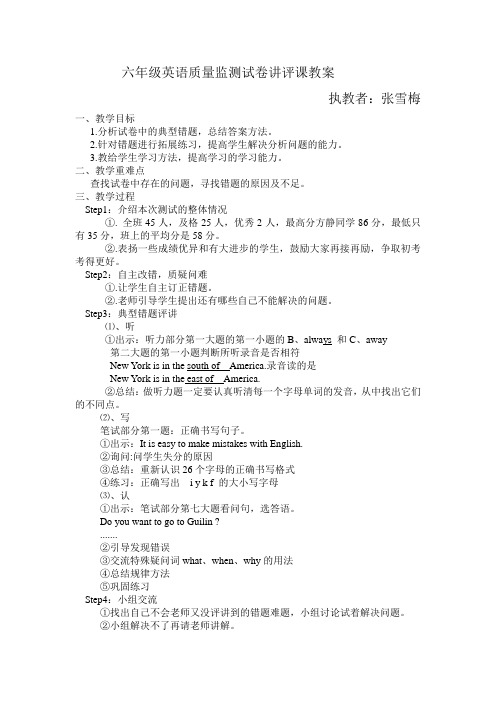
六年级英语质量监测试卷讲评课教案执教者:张雪梅一、教学目标1.分析试卷中的典型错题,总结答案方法。
2.针对错题进行拓展练习,提高学生解决分析问题的能力。
3.教给学生学习方法,提高学习的学习能力。
二、教学重难点查找试卷中存在的问题,寻找错题的原因及不足。
三、教学过程Step1:介绍本次测试的整体情况①. 全班45人,及格25人,优秀2人,最高分方静同学86分,最低只有35分,班上的平均分是58分。
②.表扬一些成绩优异和有大进步的学生,鼓励大家再接再励,争取初考考得更好。
Step2:自主改错,质疑问难①.让学生自主订正错题。
②.老师引导学生提出还有哪些自己不能解决的问题。
Step3:典型错题评讲⑴、听①出示:听力部分第一大题的第一小题的B、always 和C、away第二大题的第一小题判断所听录音是否相符New York is in the south of America.录音读的是New York is in the east of America.②总结:做听力题一定要认真听清每一个字母单词的发音,从中找出它们的不同点。
⑵、写笔试部分第一题:正确书写句子。
①出示:It is easy to make mistakes with English.②询问:问学生失分的原因③总结:重新认识26个字母的正确书写格式④练习:正确写出i y k f 的大小写字母⑶、认①出示:笔试部分第七大题看问句,选答语。
Do you want to go to Guilin ?.......②引导发现错误③交流特殊疑问词what、when、why的用法④总结规律方法⑤巩固练习Step4:小组交流①找出自己不会老师又没评讲到的错题难题,小组讨论试着解决问题。
②小组解决不了再请老师讲解。
Step5:总结谈收获板书设计听:听关键,抓不同。
写:写正确,不求快。
认:认单词,找规律。
高中英语错题(含解释)

d1.Let’s hurry up. The trian ___ . Otherwise, we won’t be able to catch it. A.is about to leave B.does leave C.leaves D.will leave句意:让我们快点。
火车即将离开。
否则,我们不能赶上它。
[固定搭配]be about to (do)刚要,即将(一般与 when 连用);be about to do...when...正要......这时......。
be about to 和 will be 两者都表示将来。
用法上的区别:be about to 是指将要做某事,或是发生某事,是指可以预见的,并且确定要发生的。
She is about to have a baby in 8 month.她8个月后就会生小孩了。
will be是指将来要发生的事或者动作,但不一定会发生。
一般只是随口一说,并不一定会实现。
I will be a doctor in the future. 我将来要做一个医生(但不一定真是这样)。
语气上的区别:两者相比,be about to 的语气要比will be的要强,要肯定一些。
(A)d2.The actor looked rather embarrassed when he forgot his ___ on stage.A.talksB.speechsC.dialoguesD.lines句意:当他在舞台上忘记台词,这位演员看上去很尴尬。
lines 台词。
talk 谈话,讲话,演讲,交谈;speech 讲话,演讲;dialogue 对话。
(D)d3.After ___ race,Jim was forced to recoginze that his brother was ___ faster runner.A.the,theB.a,theC.a,aD.the,a句意:这次比赛后,吉姆不得不承认他的哥哥比他跑得快。
初一英语组考试总结:常见错题整理与解析

初一英语组考试总结:常见错题整理与解析2023年初中一年级的英语组考试总结:常见错题整理与解析随着教育教学的不断改革和发展,英语课程已经成为了中国中小学必修的一门学科。
初中一年级的英语课程,对于学生们来说,是一个完全陌生的领域。
为了适应新的学习环境,同学们在初中一年级的英语学习中,不可避免地会犯一些错误。
为了帮助同学们更好地了解英语学习中的误区,本文将对刚刚过去的初一英语组考试中常见的错题进行整理和解析。
一、听力部分1. 错误类型:没听清题目解析:听力部分是大部分同学在英语考试中普遍认为难度较大的一项。
其中,没听清题目是同学们比较容易犯的错误。
可能是因为同学们平时在英语听说方面练习的时间不够,反应不够快,或者是在听英语短文时,对一些生词和句式不太熟悉,导致没有听清问题。
2. 错误类型:听过头或听不全解析:同学们在完成听力题时,有时会因为心情不稳(紧张、焦虑等)或听力能力不足而听过头或者听不全。
对于这种情况,同学们应该注意平时练习听力,例如听英语短片/音乐,这些可以提高同学们听英语的能力,并且听的时间越长,同学们的听力能力也会越强。
3. 错误类型:不理解问题解析:在听英语短文和问答题时,有些同学会听不懂问题所询问的内容,影响了同学们答题的准确性。
为了避免这个问题,同学们应该在平时多加练习,学习英语交际的规范和模式。
二、单项选择部分1. 错误类型:语法运用解析:其中一个常见的错误是同学们对英语语法的理解比较浅显,且一些简单的语法错误在英语考试中也会导致同学得分不理想。
较为常见的语法错误包括:主谓一致、时态误用、动词的不规则变化等。
为了避免这种情况,同学们要注重基础知识和实际应用能力的练习。
2. 错误类型:同义词辨析解析:在单项选择中,同义词的辨析经常考察。
同学们在做这类题目时,应该注意单词的区别、适用场景和常用用法。
同时,在平时的学习和做题中,要多借助词汇书和字典来了解单词在不同的语境中的适用情况。
初一英语上册错题集及分析
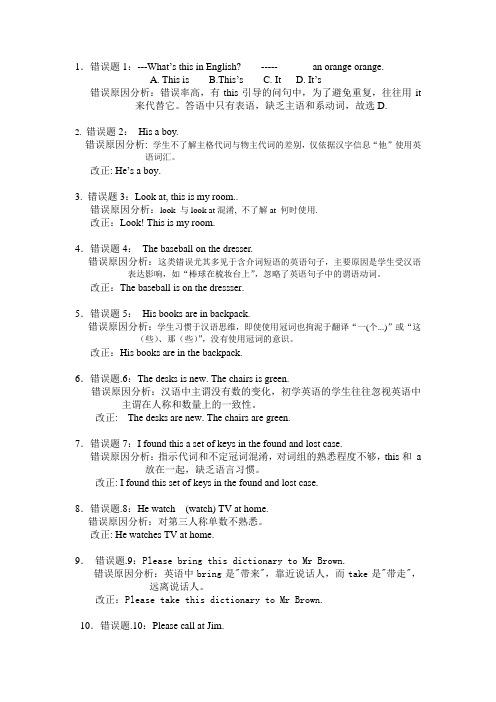
1.错误题1:---What’s this in English? -----_______an orange orange.A. This isB.This’sC. ItD. It’s错误原因分析:错误率高,有this引导的问句中,为了避免重复,往往用it 来代替它。
答语中只有表语,缺乏主语和系动词,故选D.2. 错误题2:His a boy.错误原因分析: 学生不了解主格代词与物主代词的差别,仅依据汉字信息“他”使用英语词汇。
改正: He’s a boy.3. 错误题3:Look at, this is my room..错误原因分析:look 与look at混淆, 不了解at 何时使用.改正:Look! This is my room.4.错误题4:The baseball on the dresser.错误原因分析:这类错误尤其多见于含介词短语的英语句子,主要原因是学生受汉语表达影响,如“棒球在梳妆台上”,忽略了英语句子中的谓语动词。
改正:The baseball is on the dressser.5.错误题5:His books are in backpack.错误原因分析:学生习惯于汉语思维,即使使用冠词也拘泥于翻译“一(个...)”或“这(些)、那(些)”,没有使用冠词的意识。
改正:His books are in the backpack.6.错误题.6:The desks is new. The chairs is green.错误原因分析:汉语中主谓没有数的变化,初学英语的学生往往忽视英语中主谓在人称和数量上的一致性。
改正: The desks are new. The chairs are green.7.错误题7:I found this a set of keys in the found and lost case.错误原因分析:指示代词和不定冠词混淆,对词组的熟悉程度不够,this和 a 放在一起,缺乏语言习惯。
破解英语典型错误-第六章
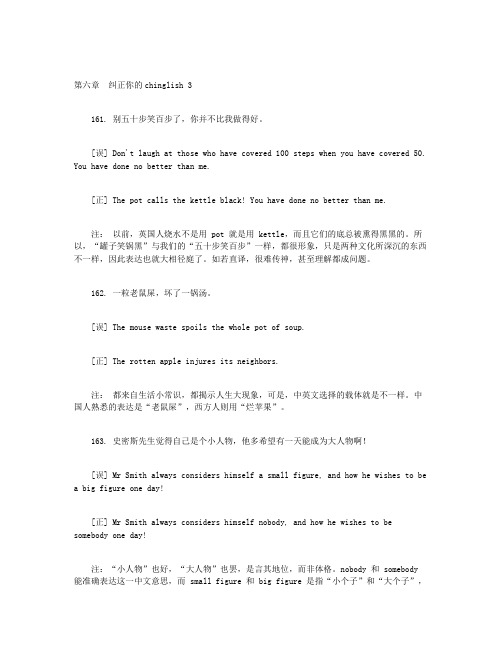
第六章纠正你的chinglish 3161. 别五十步笑百步了,你并不比我做得好。
[误] Don't laugh at those who have covered 100 steps when you have covered 50. You have done no better than me.[正] The pot calls the kettle black! You have done no better than me.注:以前,英国人烧水不是用 pot 就是用 kettle,而且它们的底总被熏得黑黑的。
所以,“罐子笑锅黑”与我们的“五十步笑百步”一样,都很形象,只是两种文化所深沉的东西不一样,因此表达也就大相径庭了。
如若直译,很难传神,甚至理解都成问题。
162. 一粒老鼠屎,坏了一锅汤。
[误] The mouse waste spoils the whole pot of soup.[正] The rotten apple injures its neighbors.注:都来自生活小常识,都揭示人生大现象,可是,中英文选择的载体就是不一样。
中国人熟悉的表达是“老鼠屎”,西方人则用“烂苹果”。
163. 史密斯先生觉得自己是个小人物,他多希望有一天能成为大人物啊![误] Mr Smith always considers himself a small figure, and how he wishes to be a big figure one day![正] Mr Smith always considers himself nobody, and how he wishes to be somebody one day!注:“小人物”也好,“大人物”也罢,是言其地位,而非体格。
nobody 和 somebody 能准确表达这一中文意思,而 small figure 和 big figure 是指“小个子”和“大个子”,不要混淆噢!164. 三个臭皮匠,顶个诸葛亮。
小学英语典型错例成因分析和改正的方法分析

在小学英语教学中,书面测试是不可缺少的一个重要部分。
但在日常教学中,老师们都会有这样的困惑:明明已经讲得很清楚了,怎么就是还有人出错呢?其实在孩子们身上所体现出来的学习上的任何一种不足,都是教师教学方式不够科学的体现。
要想抓好教学质量,使学生的书面测试达到较好的效果,那么错例分析必须是我们教学研究的一个重要方面。
下面笔者就小学生在做题时容易出现错误的成因及相关的纠正策略做以下分析:一、对语法概念模糊,理解不透彻实施新课改以来,部分教师片面强调学生语言交际能力的培养,误认为现在的小学英语教学中,语言基础知识教学特别是基本的语法教学已不重要了。
英语语法作为一种语言现象,本身是存在的,很多教师刻意回避,不向学生讲解相关的知识点,致使学生难以真正理解所学的语言材料。
另一方面,传统的语法教学使学生觉得语法学习枯燥无味,产生一定的厌学心理。
所以长期以来很多小学生对英语语法知识掌握不是很牢固,导致在语言运用时出现很多错误。
【典型错题1】单项选择。
(1)-What's this?-It's Buniform.(正确答案:A)A.aB.anC.the(2)There are sixty minutes in B hour.(正确答案:A)A.anB.aC.two【成因分析及对策】uniform这个单词的首写字母是元音字母,但是u在这个单词中发辅音/ju:/,所以前面的不定冠词应用a,而hour这个词的首写字母是辅音字母h,但开头的是元音音素/au/,所以应用an。
学生在做这一类题目时,由于不清楚有些名词开头的到底是元音音素还是辅音音素,导致在做题时往往把握不准。
教师在平时教学中可以适当地进行音标教学的渗透,在教授单词时注意对字母或字母组合的音素进行总结,可以给学有余力的学生标出音标,每册教材学完后,可以和学生一起总结本册书中出现的元音音素开头的名词。
【典型错题2】用所给词的适当形式填空。
(1)I'd like some peaehs(peach), please.(正确答案:peaches)(2)There are some brushs(brush)in these boxs(box).(正确答案:brushes, boxes)(3)I brush my tooths(tooth)every day.(正确答案:teeth)【成因分析及对策】这几道题主要是检测学生对名词复数的几种形式的掌握情况,应该说是比较简单。
初中英语学习中,如何进行有效的错题分析?

初中英语学习中,如何进行有效的错题分析?英语错题?别慌,教你玩转“错题分析”!说到英语学习,最让人头疼的莫过于错题了。
哎,每次考试完我都跟那错题本较劲儿,看着密密麻麻的红叉,简直想把它们一张一张撕成碎片!恨不得直接把它们扔进垃圾桶,永远不见!但是,等等,等等!等等!你真的以为把错题扔了就没事了吗?不不不,你可能还会再次栽在同一个坑里!我当年在初中的时候,可没少和英语错题“斗争”。
我记得有一次,在期中考试的时候,一道语法填空题就让我栽了个大跟头,当时真是想破脑袋也不知道该填什么。
最后,我硬着头皮选了个最“有可能”的答案,结果当然——错!试卷发下来之后,我盯着那道题,满脸问号:明明记得这个词组的用法是…哎呀,不对!我突然意识到,我记混了另一个类似的词组!也就是说,我在背单词和词组的时候,根本没认真去理解它们之间的细微差别。
当时啊,我真是气得不行,恨不得把那本单词书撕掉!不过,这种“暴躁”情绪持续了不到几分钟,我就冷静下来了,开始认真分析错题。
我翻阅了课本和语法书,仔细研究了这两个词组的使用场景,还专门记下了几个例句。
最后,我终于弄明白了它们之间的区别,并把它们写在了错题本上。
为了防止自己下次再犯同样的错误,我还特意把这两个词组标注了颜色,并用不同的符号区分它们的不同用法。
自从那次以后,我每次遇到不会的题,都会先耐心地分析一下题目,找出自己的错误原因:是知识点掌握不清?还是做题技巧不对?或是粗心大意?明确了原因之后,我就会针对性地进行弥补。
比如,如果是因为知识点掌握不清,我就会多做练习,并把知识点整理到我的笔记里;如果是因为做题技巧不对,我就会请教老师或同学,学习正确的解题方法;如果是粗心大意,那我就需要更加细心地做题,防止同样的错误再次发生。
说来也巧,经过我的“错题分析”训练,我竟然发现学习英语变得越来越轻松了!每次考试,我都能准确地找到自己薄弱的环节,并及时进行巩固和提高。
而且,我做错的题越来越少,这让我对英语学习充满了信心!所以说啊,不要再把错题当敌人,也不要想着怎样“消灭”它。
英语经典错题知识讲解

英语经典错题1.He __________ most of his fortune to the poor.A.gave upB. gave inC.gave awayD.gave out我的答案:C 正确答案:C2.It’s a small town. You can never dream ______a VIP in the street.A. to meetingB. of seeingC. in meetingD. on seeing我的答案:B 正确答案:B3.—What do you think of the furniture on sale?—Pretty good.But ________ what you bought with the samples I don't think it ________ the money.A.comparing;worth B.compared;worthwhileC.compare;worthy D.comparing;value我的答案:A 正确答案:A文本解析解析:句意:——你认为正在出售的这件家具怎么样?——很好。
但把你买的那件和这些样品相比较,我认为这件不值多少钱。
设空处所在句子,既无并列连词又无从属连词,由此可知第一空考查分词作状语,排除C项,主句主语I与compare之间为逻辑上的主动关系,排除B项;worth后可跟 the money/the price/钱数,故选A项。
答案:A4..—I'm worn out,________,the bike doesn't work well,so Ican't go further.—Then,we'd better have a rest here.A.apart from B.except forC.beside D.besides我的答案:D 正确答案:D文本解析解析:besides可用作副词,意为“另外,此外还有”,用于引出下面的话题信息。
活用思维导图击破英语错题
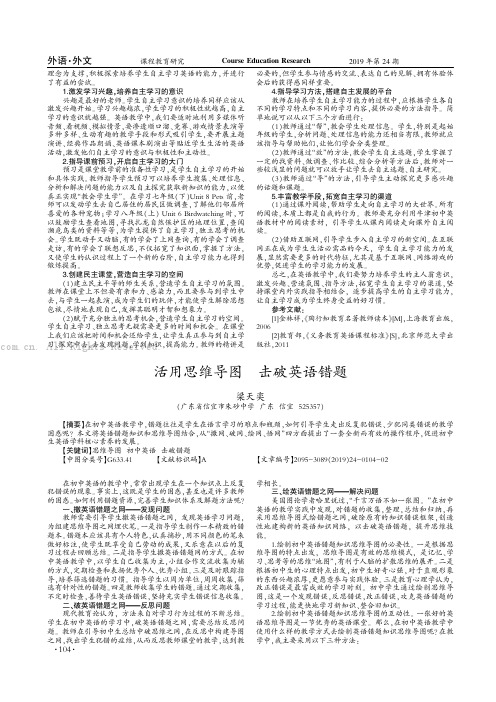
课程教育研究Course Education Research2019年第24期理念为支撑,积极探索培养学生自主学习英语的能力,并进行了有益的尝试。
1.激发学习兴趣,培养自主学习的意识兴趣是最好的老师。
学生自主学习意识的培养同样应该从激发兴趣开始。
学习兴趣越浓,学生学习的积极性就越高,自主学习的意识就越强。
英语教学中,我们要适时地利用多媒体听音频、看视频、模拟情景,要渗透顺口溜、竞赛、游戏情景表演等多种多样、生动有趣的教学手段和形式吸引学生,要开展主题演讲、经典作品朗诵、英语课本剧演出等贴近学生生活的英语活动,激发他们自主学习的意识与积极性和主动性。
2.指导课前预习,开启自主学习的大门预习是课堂教学前的准备性学习,是学生自主学习的开始和具体实践。
教师指导学生预习可以培养学生搜集、处理信息、分析和解决问题的能力以及自主探究获取新知识的能力,以便真正实现“教会学生学”。
在学习七年级(下)Unit8Pets前,老师可以发动学生去自己居住的居民区做调查,了解他们邻居所喜爱的各种宠物;学习八年级(上)Unit6Birdwatching时,可以鼓励学生查看地图,寻找扎龙自然保护区的地理位置,查阅濒危鸟类的资料等等,为学生提供了自主学习,独立思考的机会。
学生既动手又动脑,有的学会了上网查询,有的学会了调查走访,有的学会了联想反思,不仅拓宽了知识面,掌握了方法,又使学生的认识过程上了一个新的台阶,自主学习能力也得到锻炼提高。
3.创建民主课堂,营造自主学习的空间(1)建立民主平等的师生关系,营造学生自主学习的氛围。
教师在课堂上不但要有亲和力、感染力,而且要参与到学生中去,与学生一起表演,成为学生们的玩伴,才能使学生解除思想包袱,尽情地表现自己,发挥其聪明才智和想象力。
(2)赋予充分独立的思考机会,营造学生自主学习的空间。
学生自主学习、独立思考无疑需要更多的时间和机会。
在课堂上我们应该把时间和机会还给学生,让学生真正参与到自主学习、探究中去,去发现问题,学到知识,提高能力。
- 1、下载文档前请自行甄别文档内容的完整性,平台不提供额外的编辑、内容补充、找答案等附加服务。
- 2、"仅部分预览"的文档,不可在线预览部分如存在完整性等问题,可反馈申请退款(可完整预览的文档不适用该条件!)。
- 3、如文档侵犯您的权益,请联系客服反馈,我们会尽快为您处理(人工客服工作时间:9:00-18:30)。
1.He __________ most of his fortune to the poor.A.gave upB. gave inC.gave awayD.gave out我的答案:C 正确答案:C2.It’s a small town. You can never dream ______a VIP in the street.A. to meetingB. of seeingC. in meetingD. on seeing我的答案:B 正确答案:B3.—What do you think of the furniture on sale?—Pretty good.But ________ what you bought with the samples I don't think it ________ the money.A.comparing;worth B.compared;worthwhileC.compare;worthy D.comparing;value我的答案:A 正确答案:A文本解析解析:句意:——你认为正在出售的这件家具怎么样?——很好。
但把你买的那件和这些样品相比较,我认为这件不值多少钱。
设空处所在句子,既无并列连词又无从属连词,由此可知第一空考查分词作状语,排除C项,主句主语I与compare之间为逻辑上的主动关系,排除B项;worth后可跟 the money/the price/钱数,故选A项。
答案:A4..—I'm worn out,________,the bike doesn't work well,so I can't go further.—Then,we'd better have a rest here.A.apart from B.except forC.beside D.besides我的答案:D 正确答案:D文本解析解析:besides可用作副词,意为“另外,此外还有”,用于引出下面的话题信息。
apart from“除了”为介词,后面要跟宾语;beside“在……旁边”。
句意:——我累了,而且自行车也出故障了,所以我不想再往前走了。
——那么,我们最好在这里休息。
答案:D4..—I'm worn out,________,the bike doesn't work well,so I can't go further.—Then,we'd better have a rest here.A.apart from B.except forC.beside D.besides我的答案:D 正确答案:D文本解析解析:besides可用作副词,意为“另外,此外还有”,用于引出下面的话题信息。
apart from“除了”为介词,后面要跟宾语;beside“在……旁边”。
句意:——我累了,而且自行车也出故障了,所以我不想再往前走了。
——那么,我们最好在这里休息。
答案:D5.It was in New Zealand________Elizabeth first met Mr. Smith.A.thatB.howC.whichD.when我的答案:A 正确答案:A6..The building around the corner caught fire last night.The police are now ________ the matter.A.looking up B.looking outC.looking into D.looking for我的答案:C 正确答案:C文本解析解析:考查动词短语。
look up“查询,查找;向上看,看得起”;look out“当心,注意;朝外看”;look into“调查”;look for“寻找”。
句意为:街角的那座大楼昨晚着火了,警察们正在调查此事。
答案:C7.He who is easy to satisfy ________ happiness.A.has B.ownsC.belongs to D.there is我的答案:B 正确答案:B文本解析解析:belong to“属于”(主语为物,宾语为所有者);own“拥有”,侧重财产权(主语为人,宾语为物),have“有”,侧重所属关系;there be“某地有”。
句意为:容易满足的人才拥有快乐。
答案:B8.Teenagers shouldn't be ________ from school although they don't do well in studies.A.disappeared B.goneC.removed D.beaten我的答案:B 正确答案:C文本解析解析:考查动词词义辨析。
disappear“消失”;go“走”;remove“开除”;beat“打”。
由题意可知C项正确。
答案:C9.He got to the station early,______ missing his train.A.for fear of B.in search ofC.in charge of D.instead of我的答案:A 正确答案:A文本解析解析:句意:他很早就到了车站以免错过火车。
for fear of“生怕,以免”;in search of“寻找”;in charge of“负责……”;instead of“而不是”。
答案:A.10 Children above 12 are able to take part in skiing (滑雪) or other activities ________ for them.A.designed B.designingC.to design D.having designed我的答案:A 正确答案:A文本解析解析:design与other activities为动宾关系,故用过去分词短语designed for them 作后置定语。
答案:A11.Most people are ________ bringing down the price of housing because it's too high for them.A.in favor of B.in honor ofC.in search of D.in charge of我的答案:A 正确答案:A文本解析解析:句意:大部分人支持降低房价,因为房价对他们而言太高了。
in favor of“支持”;in honor of“为纪念……;为庆贺……”;in search of“寻找……”;in charge of“负责”。
答案:A12.You'll find this map of great __________ in helping you to get around London.A.price B.costC.value D.meaning我的答案:C 正确答案:C文本解析解析:句意:你将会发现这张地图在帮助你游览伦敦城方面很有价值。
price“价格”;cost“成本”;value“价值”;meaning“意思”。
答案:C13.Don't be ________ by his appearance—he is rude.A.taken apart B.taken outC.taken away D.taken in我的答案:D 正确答案:D文本解析解析:句意:别被他的外表欺骗了——他很粗鲁。
take apart“拆卸”;take out“拿出,取出”;take away“拿走,解除”;take in“接纳,接受;包括;领会,理解;欺骗”。
答案:D14.—Have you got any particular plans for the coming holiday?—Yes.________,I'm going to visit some homes for the old in the city.A.If ever B.If busyC.If anything D.If possible我的答案:D 正确答案:D文本解析解析:if possible“如果可能的话”,其完整形式为if it is possible。
省略主语it和系动词,是常见的一种状语从句的省略现象。
答案:D15.We all went out ________ the lost boy.We had ________ everywhere,but didn't find him.A.searching;searched B.searching;searched forC.in search of;searched D.in search of;searched for我的答案:C 正确答案:C文本解析解析:第一空可用in search of(寻找,搜寻)与searching for(寻找,搜寻),二者皆作状语;第二空用searched,search作“搜查”讲。
答案:C16.—What do you think of his teaching method?—It should be popular;it ________ practical.A.proves B.is provedC.has been proved D.was proved我的答案:A 正确答案:A文本解析解析:考查时态和语态。
此处的prove是系动词,表示“证明是,表明是”。
后三项中的prove都是实义动词,语法结构不太恰当,而且D项的时态不符合语境。
答案:A17.The pilot asked all the passengers on board to remain ________ as the plane was making a landing.A.seat B.seatingC.seated D.to be seating我的答案:C 正确答案:C文本解析解析:remain在句中意为“保持”,其后可跟形容词,现在分词或过去分词,意为“保持某种状态”;seated在句中作表语,强调“坐好的”状态。
答案:C18.The old man ________ the Second World War,while his friends died.A.survived B.livedC.stayed D.kept我的答案:A 正确答案:A文本解析解析:survive在此意为“挺过,幸存”。
live作及物动词时多接同源宾语life;stay “停留”,一般用作不及物动词;keep“保持”。
